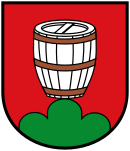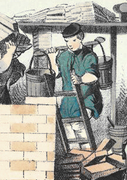bucket
The bucket, pail ( Austrian. , Switzerland. , Süddt. ), And the ampere (Austrian. Coll. ), The skid , Küfe , the vat is an open-topped, cylindrical or slightly conical container with a flat, rare curved bottom, which consists of different materials, formerly preferably wood or leather , today metal or plastic . It is a versatile means of transport. It is preferably used for the transport of liquids or bulk goods . The bucket is usually provided with a movable handle for carrying it, which can be put down when pouring out or pouring out the contents.
Word origin

The word bucket can be etymologically derived from Middle High German e (i) nber , e (i) mber , Old High German eimpar , as a loan from Latin amphora "Henkelkrug" (ahd. B (h) eran , carry to Greek φερειν ).
The handleless tub (Old High German botah , cf. English body "trunk without limbs") was increasingly replaced by the one-handled e (i) n-amber and the two- handled zuo-amber , the tub . Even North German tub , bucket or Pütze derived etymologically as Vat from.
The Bavarian - Alemannic word bucket already existed in Middle High German and was formed from Middle Latin copa , derived from the Latin word cupella, drinking vessel, mug or cupa, barrel . At the same root stands the skid , also the skid , ahd. Kuofa to cupa . Parallel is but the link with the runner than the highly curved staves : cooperage represents cooperage .
Historical
Situles and Roman buckets
Early finds of buckets in Europe are the situles , ornate bronze buckets, presumably used for cult purposes, conical with base and handle, which are attributed to the Hallstatt period and from the 6th century BC. In Slovenia, Northern Italy ( Etruscans , Italians ) and Austria ( Hallstatt culture : Magdalensberg , Hallstatt , Dürrnberg ).
From the Roman Empire, there are some findings of buckets of metal (mainly driven from brass or bronze): container with a top mounted handle, but a pedestal like a goblet . The first finds come from Hemmoor west of Hamburg , which is why the expression Hemmoorer bucket has established itself. These vessels were probably used for wine by the Romans in the 2nd and 3rd centuries . However, through Roman trade relations, they also reached areas outside the Roman Empire, where they were sometimes used as urns or grave goods. The ore fields in the western Rhineland near Eschweiler are believed to be the place of origin of the Hemmoorer bucket . In addition, wooden buckets with metal fittings were also used during the Roman Empire.
The bucket in the Middle Ages and in early modern times

Medieval bucket show up mostly of wooden staves with iron fittings and were from Cooper (also Kübler or coopers manufactured). The bucket was either carried in hand or on a carrying pole . The Grimmsche German Dictionary describes the bucket as "a round vessel, situla, made of wood, sheet metal, porcelain with a movable handle to hang on and carry" and notes: "Today we mean by bucket that which contains and contains". The bucket was used as a measure of capacity until modern times (example: five buckets of water ) and in the 19th century corresponded to either around 12 liters - about the size of a 10 or 15 liter bucket that is common today - or around 60 liters, the Bar bucket (compare bar measure ). This was intended to be carried by two people on a support bar .
Late medieval and modern arrangements also served to prevent a fire and to store and use fire buckets. In 1470, Duke Sigmund IV of Austria-Tyrol stipulated in a municipal fire code for Bolzano that the Fassbinder should purchase 25 water works and, if the buckets were lost, the city council should pay damages. Count Palatine Karl IV ordered in 1772 for Obertiefenbach that every landlord always had a tub filled with water ready and a leather fire bucket with a name at hand. Each municipality had to keep a certain number of buckets in stock. No resident was allowed to marry or be accepted as a subject who had not supplied the community buckets with a new one with the year and name.

- Various uses of buckets
Conveyor buckets in mining
The runner

Skid in the coat of arms of Kufstein
|
The Kufe (Küfe) is included in the older literature in particular as a salt barrel for transporting salt . The carrying device was hooked into the runner, the barrel itself has no handle. Here, too, the concept of a measure of capacity is present. The runners were of different sizes. A full runner for horses weighed around 55 kg, while large runners for transporting salt on wagons weighed around 74 kg.
Perkufe is the term used to describe truncated cone-shaped runners that are open at the bottom and have a drainage hole at the top, which are filled with the moist salt paste like a funnel through the large opening on the Perstatt , after the brine has drained and the contents have dried, they are overturned and lifted off. The salt content remained as a truncated cone for further processing. For centuries, these salt cones (salt domes ) were the common transport container of largely standardized size.
The skid was, according to the value of the salt and the reliability of the measurement, also a measure for taxes and customs.
Designs
In addition to simple buckets, there are also those with a spout ("beak") or with a tightly fitting lid . The folding bucket is a space-saving model in terms of storage .
use
The bucket is used:
- in everyday life, for example, as a garbage can or paper basket
- in household , agriculture , horticulture and construction as a transport and storage device with a wide range of uses
- as a planter for potted plants
- the extinguishing bucket as a small extinguisher
- as Pütz in shipping for various tasks
See also
- Toilet bucket , a mountain man's toilet
- Bucket smoking , a misappropriation of drug culture
- Conveyor bucket , a transport bucket used in mining
- Schaff , an open, wooden container
Web links
Individual evidence
- ↑ Etymology. Duden Volume 7. Bibliographisches Institut, Mannheim 1997, ISBN 3-411-20907-0 .
- ↑ a b bucket , m. situla, amphora, urna, ahd . In: Jacob Grimm , Wilhelm Grimm (Hrsg.): German dictionary . tape 3 : E – research - (III). S. Hirzel, Leipzig 1862 ( woerterbuchnetz.de ).
- ↑ Another explanation: Bucket from Einbar = a liquid container carried by a handle in contrast to the tub, which is derived from zwie and bar because this container has two handles. Source: Our vocabulary , Georg Westermann Verlag, Braunschweig 1972, p. 392 and 392 L (for teachers ?). The meaning of bar remains unclear here. If it comes from -bar meaning can because a bucket be carried with one hand and a tub with two hands can ? Or does it come from the ancient Greek pherein with the meaning to carry ? So single-carrier and double-carrier? Or maybe one and two?
- ↑ see list of nautical technical terms
- ↑ a b skid . In: Former Academy of Sciences of the GDR, Heidelberg Academy of Sciences (Hrsg.): German legal dictionary . tape 8 , issue 2 (edited by Heino Speer and others). Hermann Böhlaus successor, Weimar 1985, OCLC 832567175 ( adw.uni-heidelberg.de - continued in the following issue).
- ↑ Kufe , f. vessel . In: Jacob Grimm , Wilhelm Grimm (Hrsg.): German dictionary . tape 11 : K - (V). S. Hirzel, Leipzig 1873 ( woerterbuchnetz.de ).
- ↑ Kufe , f. sled runner u. Ä . In: Jacob Grimm , Wilhelm Grimm (Hrsg.): German dictionary . tape 11 : K - (V). S. Hirzel, Leipzig 1873 ( woerterbuchnetz.de ).
- ^ Manfred Scheuch: Austria. Province, empire, republic. Das Beste and Brandstätter Verlag, Vienna 1994, ISBN 3-87070-588-4 , pp. 11, 12f
- ↑ Michael Erdrich: To the brass buckets of the Hemmoorer type: distribution, dating and production. In: Rome on the Lower Elbe . Exhibition catalog, Neumünster 1995, pp. 71–80. ISBN 3-529-01836-8 .
- ↑ archaeologically dusted the Hemmoorer bucket . ( Memento of February 5, 2001 in the Internet Archive ) Find of the month. In: archaeological .
- ^ Entry Schankeimer in Meyers Konversations-Lexikon
- ^ Hannes Obermair : Written form and documented tradition of the city of Bozen up to 1500 . In: Bozen Süd - Bolzano Nord . tape 2 . Bolzano 2008, ISBN 978-88-901870-1-8 , pp. 139, no.1107 .
- ^ Franz-Josef Sehr : The fire extinguishing system in Obertiefenbach from earlier times . In: Yearbook for the Limburg-Weilburg district 1994 . The district committee of the Limburg-Weilburg district, Limburg-Weilburg 1993, p. 151-153 .
- ↑ Český Krumlov: image of a salt carrier. accessed on September 8, 2019
- ↑ Český Krumlov: The Salt Trail. Retrieved December 30, 2008











